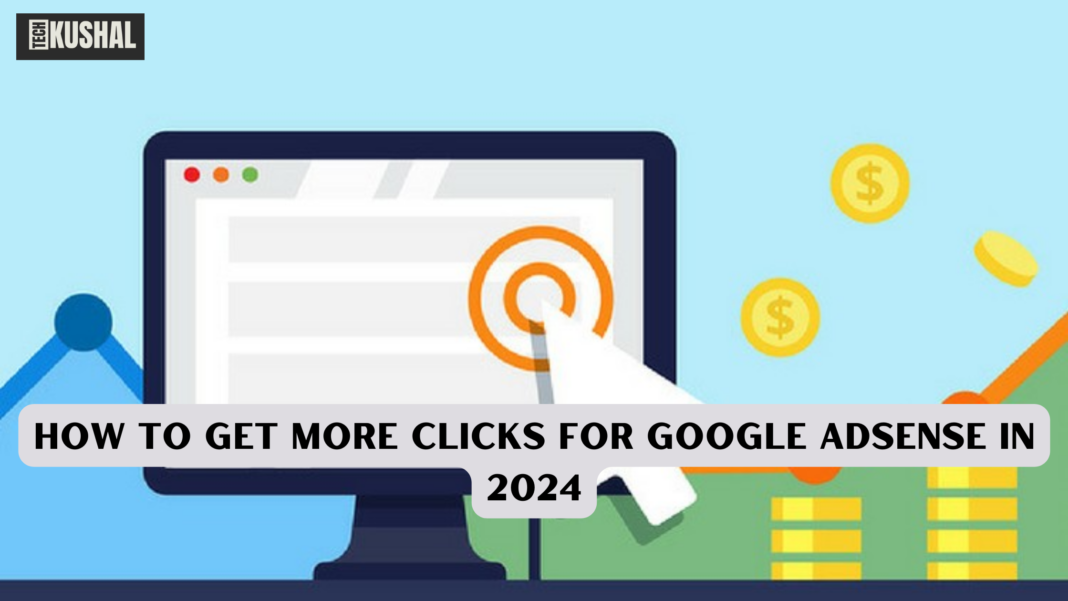
How to Get More Clicks for Google AdSense, in the ever-evolving world of digital marketing, optimizing your Google AdSense strategy is crucial to maximizing revenue. With the right tactics, you can significantly increase the number of clicks on your ads, thereby boosting your earnings. This comprehensive guide will delve into effective strategies to get more clicks for Google AdSense in 2024.
Read More: How to Track Daily Changes in Gold Rates 2024
Understanding the Importance of Ad Placement

Strategic Ad Placement
The placement of your ads plays a pivotal role in determining their click-through rate (CTR). Placing ads above the fold, where they are immediately visible without scrolling, can increase visibility and clicks. Consider integrating ads within the content, especially in areas where users are most engaged. For instance, placing ads between paragraphs or within content that answers a user’s query can lead to higher engagement.
Responsive Ad Units
With the increasing use of mobile devices, ensuring that your ads are responsive is crucial. Responsive ad units automatically adjust their size to fit different screen sizes, providing a better user experience and increasing the likelihood of clicks. Google AdSense offers responsive ad units that adapt to various devices, making it easier to optimize for mobile traffic.
Optimizing Ad Formats and Sizes

Experiment with Different Ad Formats
Google AdSense offers various ad formats, including text ads, display ads, and rich media ads. Experimenting with different formats can help you identify which ones perform best on your site. For instance, text ads may work well in content-heavy areas, while display ads might be more effective in visually-oriented sections.
Experiment with Different Ad Formats
Certain ad sizes tend to perform better than others. The most effective ad sizes include 728×90 (Leaderboard), 336×280 (Large Rectangle), and 300×600 (Half Page). These sizes are highly visible and blend well with most website layouts, making them more likely to attract clicks.
Enhancing Ad Relevance

Targeted Content
Creating targeted content that aligns with your audience’s interests can significantly improve ad relevance. Use keyword research to identify topics that your audience is searching for and create content around those topics. When your content is relevant to your audience, the ads displayed will also be more relevant, increasing the chances of clicks.
Ad Customization
Customizing the appearance of your ads to match the look and feel of your website can improve user experience and increase CTR. Google AdSense allows you to customize ad colors, fonts, and styles to blend seamlessly with your site’s design. This reduces ad blindness and makes users more likely to engage with your ads.
Improving Page Load Speed

Optimize Website Performance
Page load speed is a critical factor in user experience and can impact your ad revenue. Slow-loading pages can lead to higher bounce rates and lower ad engagement. Optimize your website’s performance by compressing images, minimizing CSS and JavaScript files, and leveraging browser caching. Tools like Google PageSpeed Insights can help you identify areas for improvement.
Accelerated Mobile Pages (AMP)
Implementing AMP can significantly improve the load time of your mobile pages. AMP is a framework designed to create fast-loading mobile web pages. By using AMP, you can provide a better user experience for mobile users, leading to higher engagement and more ad clicks.
Leveraging AdSense Features
AdSense Experiments
Google AdSense offers a feature called AdSense Experiments that allows you to test different ad settings and compare their performance. Use this feature to experiment with different ad placements, formats, and styles to determine what works best for your site. Analyzing the results can provide valuable insights and help you optimize your ad strategy.
Auto Ads
Auto Ads use machine learning to automatically place ads on your site in optimal locations. This feature takes the guesswork out of ad placement and ensures that ads are placed where they are most likely to be seen and clicked. Enabling Auto Ads can help you maximize your ad revenue with minimal effort.
Analyzing Performance and Making Adjustments

Regular Performance Reviews
Regularly reviewing your ad performance is essential to identify areas for improvement. Use the AdSense dashboard to monitor key metrics such as CTR, revenue, and ad impressions. Look for patterns and trends that can provide insights into what’s working and what’s not.
A/B Testing
Conducting A/B tests is an effective way to determine the impact of different ad strategies. Test variables such as ad placement, size, and format to see which combinations yield the best results. Make data-driven decisions based on the outcomes of your A/B tests to continually optimize your ad strategy.
Conclusion
Maximizing your Google AdSense clicks requires a strategic approach that involves optimizing ad placement, experimenting with different formats, enhancing ad relevance, improving page load speed, leveraging AdSense features, and regularly analyzing performance. By implementing these strategies, you can significantly boost your ad revenue in 2024.
By implementing these strategies, you can enhance your Google AdSense performance and increase your revenue in 2024. Focus on creating high-quality content, optimizing ad placements, and ensuring a positive user experience to achieve the best results.
FAQs for How to Get More Clicks for Google AdSense in 2024
What is Google AdSense and How Does It Work?
Google AdSense is a program that enables website owners to earn revenue by displaying targeted ads on their sites. Advertisers bid to show ads relevant to the content of the website, and owners earn money when visitors click on these ads. The key to boosting AdSense earnings lies in increasing the number of clicks and optimizing ad placements.
How Can I Optimize My Ad Placement for More Clicks?
1. Strategic Ad Placement
Strategic placement of ads is vital. Ensure ads are positioned in high-visibility areas such as:
- Above the fold: Place ads in the upper section of your webpage, where users are more likely to see them without scrolling.
- Within content: Embed ads within the content to increase visibility as users read through your articles.
- Sidebar and header: These locations often catch the user’s eye due to their prominent positions.
2. Use of Responsive Ads
Responsive ads automatically adjust their size and format to fit different screen sizes and orientations. This flexibility ensures that ads are displayed correctly on both desktop and mobile devices, enhancing user experience and potentially increasing clicks.
3. Balancing Ads and Content
While ads are crucial, they should not overwhelm your content. A balanced ratio ensures that your site remains user-friendly, retaining visitors and encouraging ad clicks without compromising on the quality of your content.
What Type of Content Drives More AdSense Clicks?
1. High-Quality, Engaging Content
Content is king, and high-quality, engaging content can significantly impact your CTR. Focus on creating:
- Informative articles: Content that provides value and answers questions effectively.
- Interactive media: Videos, infographics, and interactive polls that captivate users.
2. Niche-Specific Content
Targeting a specific niche can attract a dedicated audience interested in your subject matter. This relevance increases the likelihood of ad engagement, as users are more likely to find the ads pertinent to their interests.
3. Long-Form Content
Longer articles tend to perform better in search rankings and keep users on your site for extended periods. This increased dwell time enhances the chances of ad clicks.
How Important is Mobile Optimization for AdSense Clicks?
With a significant portion of web traffic coming from mobile devices, mobile optimization is non-negotiable. Ensure your website is:
- Mobile-friendly: Use responsive design to adapt your site for various screen sizes.
- Fast-loading: Optimize images and minimize code to improve load times on mobile devices.
- Easy to navigate: Simplify menus and ensure buttons are easily clickable on smaller screens.
How Can I Leverage SEO to Increase AdSense Revenue?
1. Keyword Research
Conduct thorough keyword research to identify terms your target audience is searching for. Incorporate these keywords naturally into your content to improve search engine rankings and attract organic traffic.
2. On-Page SEO
Optimize on-page elements such as:
- Title tags and meta descriptions: Ensure they are compelling and keyword-rich.
- Header tags: Use H1, H2, and H3 tags to structure your content and improve readability.
- Internal linking: Link to related articles within your site to keep users engaged and explore more content.
3. Backlink Building
Acquiring high-quality backlinks from reputable sites can boost your domain authority and improve your search rankings. This increased visibility can lead to higher traffic and more ad clicks.
What Role Does User Experience Play in AdSense Success?
A positive user experience (UX) is essential for retaining visitors and encouraging ad clicks. Focus on:
- Website design: A clean, professional design enhances credibility and user trust.
- Navigation: Easy-to-use navigation helps users find information quickly.
- Load speed: Fast-loading pages reduce bounce rates and keep users engaged.
Are There Any AdSense Policy Guidelines I Should Follow?
Adhering to AdSense policies is crucial to maintaining your account and maximizing revenue. Key guidelines include:
- Content guidelines: Ensure your content is original, valuable, and complies with AdSense policies.
- Click fraud prevention: Do not encourage users to click on ads. Click fraud can lead to account suspension.
- Ad placement policies: Follow guidelines for ad placement to avoid accidental clicks and ensure a positive user experience.
How Can I Track and Analyze AdSense Performance?
1. Google Analytics
Integrate Google Analytics with your AdSense account to gain insights into user behavior and ad performance. Key metrics to track include:
- Page views: Understand which pages attract the most traffic.
- Bounce rate: Identify pages where users leave quickly and investigate possible issues.
- Click-through rate (CTR): Monitor the effectiveness of your ad placements.
2. AdSense Reports
Regularly review AdSense reports to identify trends and optimize your strategy. Focus on:
- Earnings reports: Track your daily, weekly, and monthly earnings.
- Ad performance: Analyze which ads are performing well and adjust placements accordingly.


